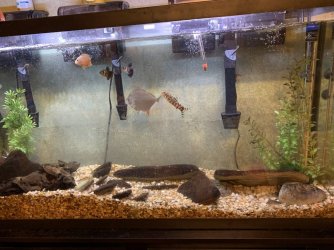My boyfriend has a 75 gallon tank that is literally a doom tank. Everything dies eventually sooner than it should. To count this tank has claimed 2 plecos, 9 tiger barbs, 2 Cory cats all one by one.
Now bare with me.
I asked him to test his water today
0 ammonia
40 nitrate
2.0 nitrite
8.0 ph
80°
Weekly 30% changes treated with aquarium salt and dechlorinator
Plan is
Large water change, clean tank, fill with treated water and then treat whole tank with aquarium salt, hopefully lower nitrites
Day after test PH and use either ph up/down to balance to 7
Currently homes 1 small parrot, 3 black tetras, 2 yo-yo loaches, 1 silver dollar and 2 small Cory’s
We understand the mix is not ideal but it’s nit what started in this tank, more like fish saved from someone who was just going to flush them, so please keep focus on just tips to get this tank to be a safe home.
Now bare with me.
I asked him to test his water today
0 ammonia
40 nitrate
2.0 nitrite
8.0 ph
80°
Weekly 30% changes treated with aquarium salt and dechlorinator
Plan is
Large water change, clean tank, fill with treated water and then treat whole tank with aquarium salt, hopefully lower nitrites
Day after test PH and use either ph up/down to balance to 7
Currently homes 1 small parrot, 3 black tetras, 2 yo-yo loaches, 1 silver dollar and 2 small Cory’s
We understand the mix is not ideal but it’s nit what started in this tank, more like fish saved from someone who was just going to flush them, so please keep focus on just tips to get this tank to be a safe home.



